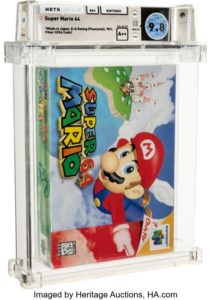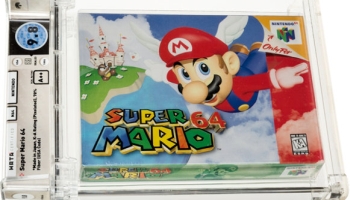 Just days after a sealed and graded copy of The Legend of Zelda sold at auction for $870,000, a similarly-preserved copy of Super Mario 64 sold for nearly twice that amount… $1.56 million to be exact.
Just days after a sealed and graded copy of The Legend of Zelda sold at auction for $870,000, a similarly-preserved copy of Super Mario 64 sold for nearly twice that amount… $1.56 million to be exact.
This is the first time a single game has sold for more than a million dollars, but surprisingly, there’s not much that’s particularly noteworthy about this copy of Mario’s first 3D adventure.
As usual, bidders seem to have zeroed in on this specific auction because it’s still sealed (a must for transactions like this) and because the box is in tremendous shape.
But collectors looking for a one-of-a-kind purchase won’t find that with Super Mario 64. Nintendo sold almost 12 million copies of the game between 1996 and 2001, which actually makes it the most common game from the N64/PlayStation/Saturn era. Nor are sealed copies particularly rare. Four others were also available this weekend during a “Video Game Signature Auction” at Heritage.
Besides rarity, the condition of the box is also very important to people who spend serious money on retro video games. But anyone who owned a copy of Super Mario 64 will surely remember that the cardboard used in the packaging was almost comically fragile. Combined with the flimsiness of each game’s inner tray, you’re unlikely to find many copies of Super Mario 64 that don’t look crushed or dented in some way (which was also true of most copies that were fresh off the production line in 1996).
The pristine nature of this copy’s packaging is reflected in a 9.8 A++ grade from Wata, an evaluation and authentication company for collectibles, and an emphasis on the cardboard’s condition was the main talking point in the description at Heritage Auctions:
The cultural significance of this title and its importance to the history of video games is paramount, and the condition of this copy is just so breathtaking that we’re really at a loss here. If you have had your heart set on obtaining the highest graded copy of the single best-selling video game on the Nintendo 64 — the first 3D adventure of Nintendo’s mascot, Mario — we only have one piece of advice: this is not an opportunity to waste.
All that said, there’s still no logical reason why this game should be worth this much money. Seven figures is a lot of money to pay for an extremely common game that’s encased in a nicely manufactured piece of cardboard and some shrink wrap. There likely must be dozens, perhaps hundreds, of nearly identical copies of this game in a similar condition in the wild.
I guess we have to fall back on that old adage among collectors for this one… it doesn’t matter what the price guide says, something is worth what someone will pay.

